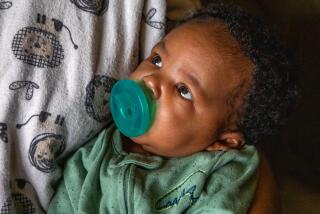Crib Death Risk Tied to Sleeping on Stomach
- Share via
Contradicting a long-held belief, the American Academy of Pediatrics on Wednesday recommended that healthy babies born at term should sleep on their side or back, not on their stomachs, suggesting that the prone position could increase the risk of Sudden Infant Death Syndrome.
The recommendation follows a review of a growing number of medical studies from around the world supporting a link between the stomach-down, or prone, sleeping position and an increased risk of Sudden Infant Death Syndrome. The syndrome, the leading cause of death for babies between the age of 1 month and 1 year, is commonly known as SIDS.
“The weight of the evidence implicates the prone position as a significant risk factor for SIDS,” said the report by the academy, a leading organization of pediatricians.
The report, released at an academy meeting in New York City, acknowledged that a relationship between SIDS and sleeping position has not been proven and that the ultimate cause of crib death is not known. “We do not know what impact this will have,” said Dr. John Brooks of the University of Rochester Medical Center in New York, one of three members of an academy task force that prepared the report.
While sudden infant death is uncommon, it is a major source of apprehension and confusion among parents. Each year, there are about 4 million live births in the United States and 6,000 SIDS deaths.
Most of the SIDS cases occur in apparently healthy infants under 6 months of age who had been put to bed without any signs of illness. The peak incidence is between 2 and 3 months of age, with few cases before 2 weeks or after 6 months. Babies born prematurely and those with previous life-threatening events are at greater risk and account for about a quarter of the cases, Brooks said.
While the exact cause of the ailment remains elusive, there is no shortage of theories. Most relate to deficiencies in the newborn resulting in a failure to adapt to life outside of the womb, such as subtle neurologic, cardiac or respiratory problems.
There is also no clear explanation of why sleeping stomach-down--the most common position for infants in the United States--may contribute to the risk of SIDS, although some researchers have conjectured that it may predispose a small number of infants to suffocate through blockage of the narrow airway from the mouth to the lungs.
The American Academy of Pediatrics report cautioned that “although the relative risk of the prone position may be several times that of the lateral or supine position, the actual risk of SIDS when placing an infant in a prone position is still extremely low.”
The report did not estimate the actual rates. The average incidence rate for SIDS in the United States ranges from 1.6 to 2.3 per 1,000 live births, with rates typically lower in Asians and whites than Latinos and blacks.
During the first few months of life, the position in which the baby is placed to sleep is generally the position the infant maintains throughout sleep. Over the years, many pediatricians and parents in the United States have been concerned that infants who sleep on their backs may be at increased risk of inhaling spit or regurgitated milk or formula into their lungs.
This concern over what is known in medical terms as aspiration has prompted many parents to place babies on their stomach to sleep. But the task force said it was unable to find medical evidence to support a relation between aspiration and babies sleeping on their backs. “Aspiration is a very rare cause of infant death,” the report said.
There “appears to be little hazard” for healthy infants from sleeping on their side or their back, according to the report. The group cautioned, however, that “there are still good reasons for placing certain infants prone.” These babies include premature infants with breathing problems, infants with frequent vomiting or spitting, and infants with anomalies that predispose them to obstruction of their breathing passages.
In support of its recommendation, the pediatrics group, which is based in Elk Grove Village, Ill., cited the results of 11 scientific studies, mostly from Australia, Britain and New Zealand. It also cited additional “very preliminary reports” from Britain and New Zealand noting “decreases in the incidence of SIDS by more than 50%, coincident with a change in sleeping positions from mostly prone to predominantly supine or lateral” and “an abrupt increase” in SIDS deaths in the Netherlands during the 1970s when the predominant sleeping position changed from supine to prone.
While the academy thought that the evidence was sufficiently compelling to warrant action, some SIDS experts, such as Thomas Keens of the USC School of Medicine, expressed concern that the recommendation was premature. “This is building a bit of false hope,” Keens said. “I do not think this is going to solve the problem.”
Significantly, the National Institute of Child Health and Human Development, which coordinates federally funded SIDS research, has not issued its own recommendation.
“It is unknown whether a nationwide change in infant sleeping position will change the incidence of SIDS in this country,” the institute said in a statement. The institute said it will sponsor additional research on the topic.
The institute cautioned that studies in other countries may not be relevant to the United States because of differences in other factors that may be related to SIDS, such as types of infant bedding, house heating and cooling methods, breast feeding and maternal smoking habits. For instance, the use of thick wool blankets, which may contribute to SIDS by putting infants at risk of suffocation, is believed to be more common in Australia and New Zealand than in the United States.
The new recommendation is likely to deluge the nation’s pediatricians with questions from parents. While many pediatricians had been aware that a policy on infant sleeping position was under consideration, most have yet to see the report, which is to be published in June in the journal Pediatrics.
Thomas Moran, president of the Sudden Infant Death Syndrome Alliance, a national voluntary organization based in Columbia, Md., called the recommendation “prudent and timely.”
Keens, of USC, predicted that most pediatricians will “grab” the recommendation because of the prestige of the American Academy of Pediatrics and the frustration of not being able to do anything to prevent SIDS.






